Principles of Organizational Talent Management Report
VerifiedAdded on 2020/04/21
|9
|1678
|208
Report
AI Summary
This report, focusing on the principles of organizational talent management, explores the critical aspects of building a robust and effective workforce. It begins with an executive summary highlighting the significance of talent management in organizational success. The report delves into various techniques organizations can use to develop high-potential talent internally, including clarifying job profiles, assessing employee aptitudes, and providing continuous training and incentives. A systematic process for talent building is outlined, encompassing identifying job requirements, assessing skills, providing training, monitoring performance, and offering rewards. The report also emphasizes the importance of succession planning to mitigate talent deficits and ensure organizational continuity, discussing the roles and responsibilities of the succession planning team. Real-world examples, such as Google, Starbucks, and Citigroup, are used to illustrate the practical application of these concepts, concluding that effective talent management is essential for organizational health and long-term success. The report emphasizes the importance of nurturing and developing employees through efficient care, responsibility, and guidance, highlighting the need for well-designed talent management programs and successful succession planning.
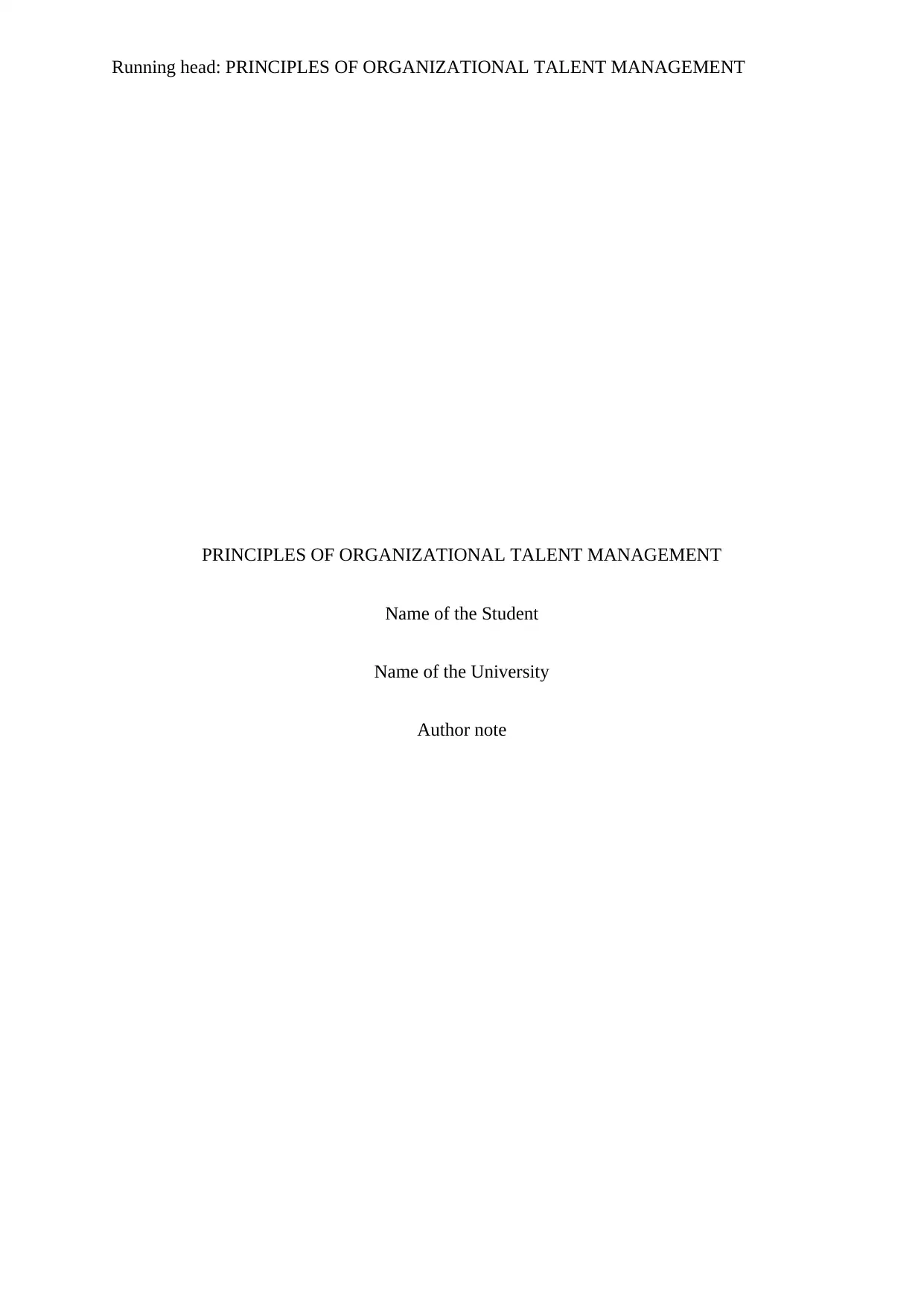
Running head: PRINCIPLES OF ORGANIZATIONAL TALENT MANAGEMENT
PRINCIPLES OF ORGANIZATIONAL TALENT MANAGEMENT
Name of the Student
Name of the University
Author note
PRINCIPLES OF ORGANIZATIONAL TALENT MANAGEMENT
Name of the Student
Name of the University
Author note
Paraphrase This Document
Need a fresh take? Get an instant paraphrase of this document with our AI Paraphraser
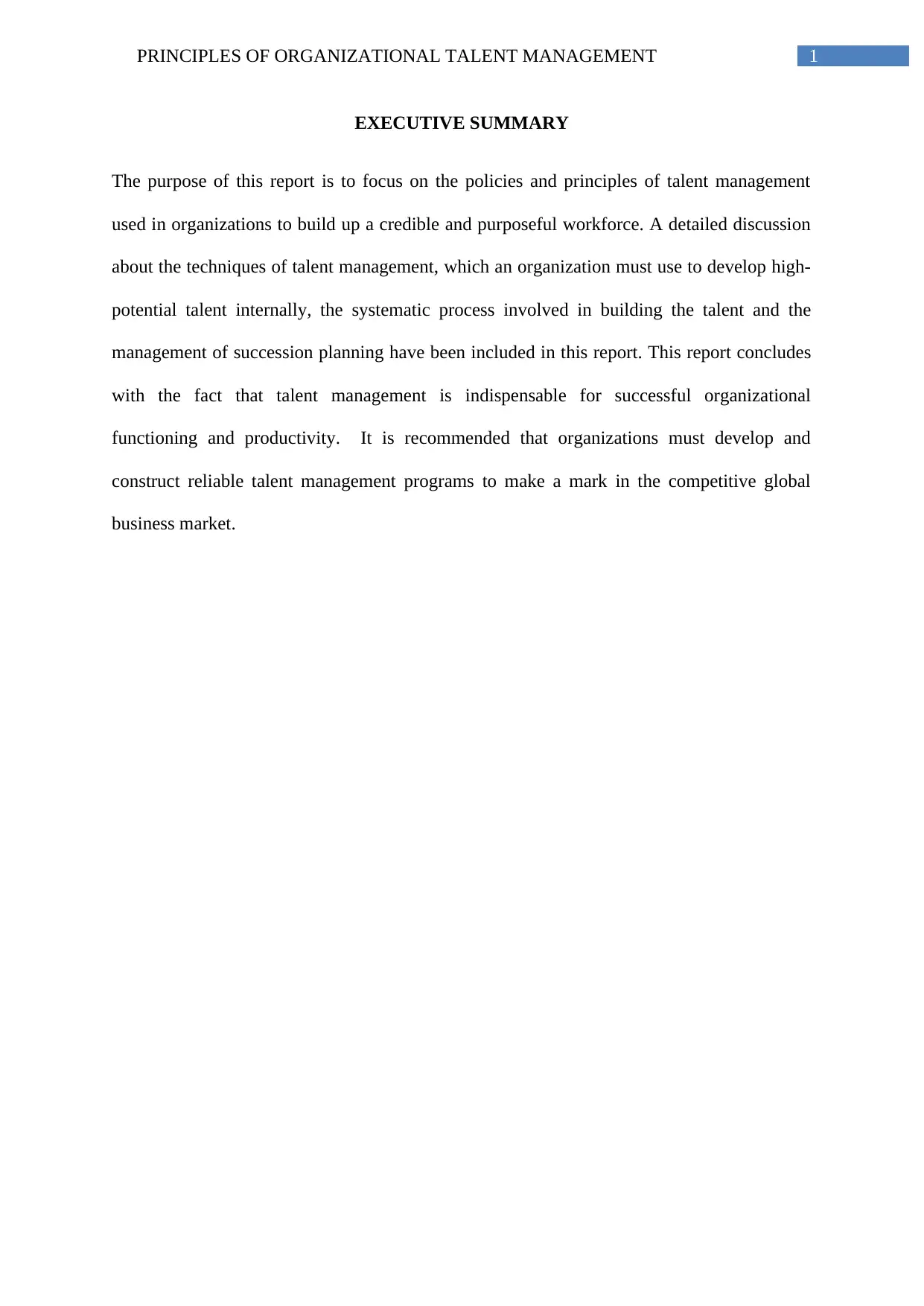
1PRINCIPLES OF ORGANIZATIONAL TALENT MANAGEMENT
EXECUTIVE SUMMARY
The purpose of this report is to focus on the policies and principles of talent management
used in organizations to build up a credible and purposeful workforce. A detailed discussion
about the techniques of talent management, which an organization must use to develop high-
potential talent internally, the systematic process involved in building the talent and the
management of succession planning have been included in this report. This report concludes
with the fact that talent management is indispensable for successful organizational
functioning and productivity. It is recommended that organizations must develop and
construct reliable talent management programs to make a mark in the competitive global
business market.
EXECUTIVE SUMMARY
The purpose of this report is to focus on the policies and principles of talent management
used in organizations to build up a credible and purposeful workforce. A detailed discussion
about the techniques of talent management, which an organization must use to develop high-
potential talent internally, the systematic process involved in building the talent and the
management of succession planning have been included in this report. This report concludes
with the fact that talent management is indispensable for successful organizational
functioning and productivity. It is recommended that organizations must develop and
construct reliable talent management programs to make a mark in the competitive global
business market.
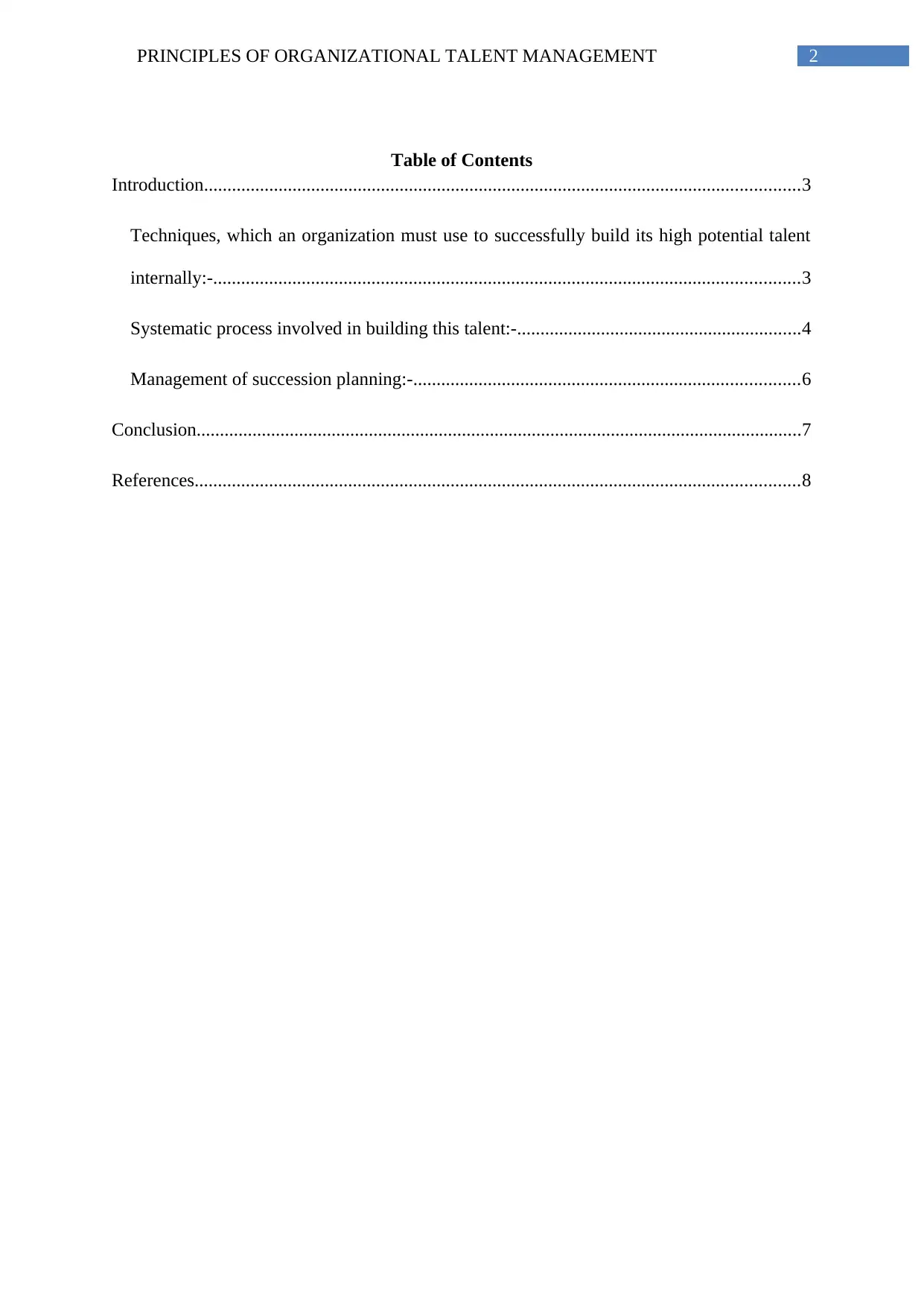
2PRINCIPLES OF ORGANIZATIONAL TALENT MANAGEMENT
Table of Contents
Introduction................................................................................................................................3
Techniques, which an organization must use to successfully build its high potential talent
internally:-..............................................................................................................................3
Systematic process involved in building this talent:-.............................................................4
Management of succession planning:-...................................................................................6
Conclusion..................................................................................................................................7
References..................................................................................................................................8
Table of Contents
Introduction................................................................................................................................3
Techniques, which an organization must use to successfully build its high potential talent
internally:-..............................................................................................................................3
Systematic process involved in building this talent:-.............................................................4
Management of succession planning:-...................................................................................6
Conclusion..................................................................................................................................7
References..................................................................................................................................8
⊘ This is a preview!⊘
Do you want full access?
Subscribe today to unlock all pages.

Trusted by 1+ million students worldwide
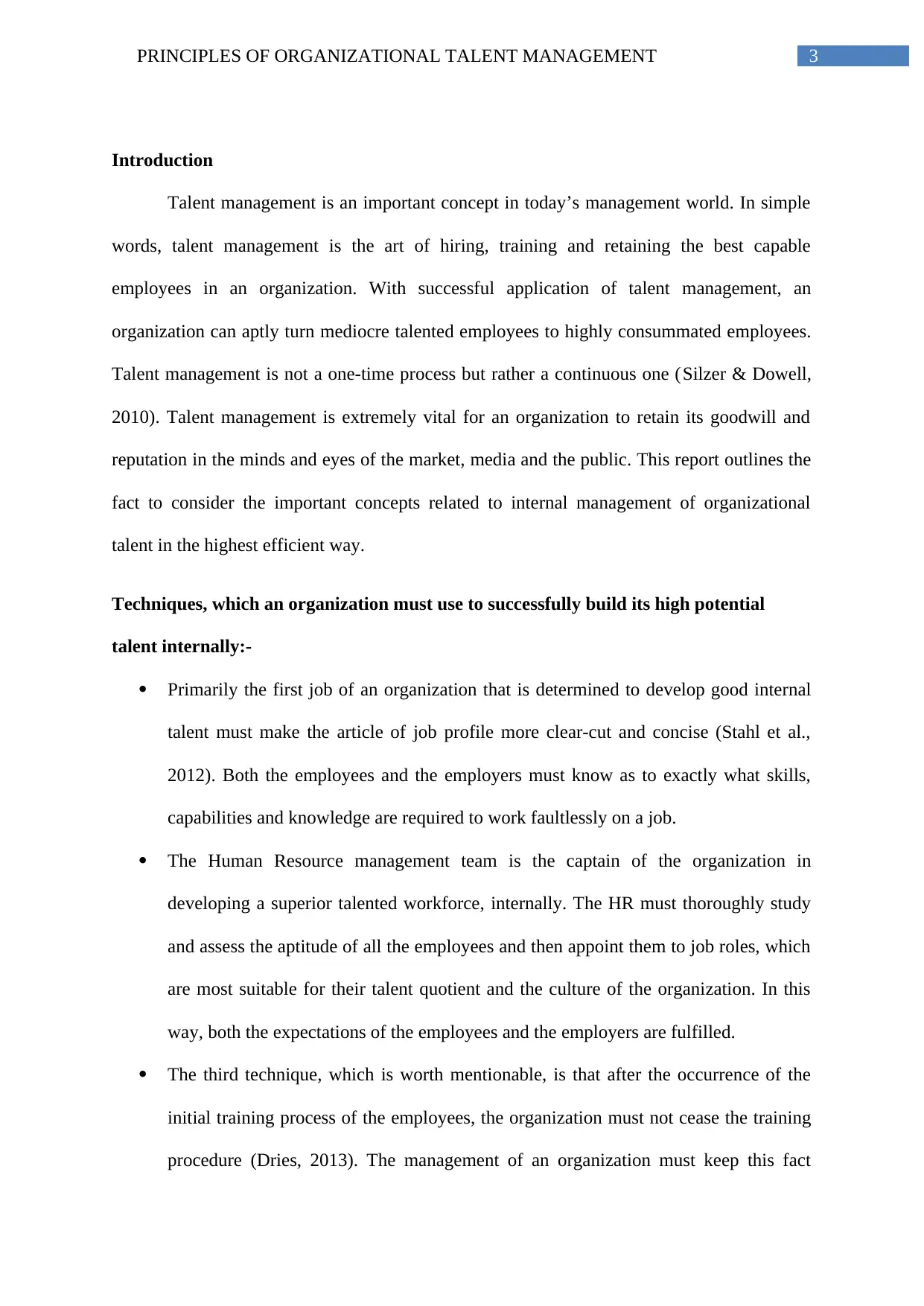
3PRINCIPLES OF ORGANIZATIONAL TALENT MANAGEMENT
Introduction
Talent management is an important concept in today’s management world. In simple
words, talent management is the art of hiring, training and retaining the best capable
employees in an organization. With successful application of talent management, an
organization can aptly turn mediocre talented employees to highly consummated employees.
Talent management is not a one-time process but rather a continuous one (Silzer & Dowell,
2010). Talent management is extremely vital for an organization to retain its goodwill and
reputation in the minds and eyes of the market, media and the public. This report outlines the
fact to consider the important concepts related to internal management of organizational
talent in the highest efficient way.
Techniques, which an organization must use to successfully build its high potential
talent internally:-
Primarily the first job of an organization that is determined to develop good internal
talent must make the article of job profile more clear-cut and concise (Stahl et al.,
2012). Both the employees and the employers must know as to exactly what skills,
capabilities and knowledge are required to work faultlessly on a job.
The Human Resource management team is the captain of the organization in
developing a superior talented workforce, internally. The HR must thoroughly study
and assess the aptitude of all the employees and then appoint them to job roles, which
are most suitable for their talent quotient and the culture of the organization. In this
way, both the expectations of the employees and the employers are fulfilled.
The third technique, which is worth mentionable, is that after the occurrence of the
initial training process of the employees, the organization must not cease the training
procedure (Dries, 2013). The management of an organization must keep this fact
Introduction
Talent management is an important concept in today’s management world. In simple
words, talent management is the art of hiring, training and retaining the best capable
employees in an organization. With successful application of talent management, an
organization can aptly turn mediocre talented employees to highly consummated employees.
Talent management is not a one-time process but rather a continuous one (Silzer & Dowell,
2010). Talent management is extremely vital for an organization to retain its goodwill and
reputation in the minds and eyes of the market, media and the public. This report outlines the
fact to consider the important concepts related to internal management of organizational
talent in the highest efficient way.
Techniques, which an organization must use to successfully build its high potential
talent internally:-
Primarily the first job of an organization that is determined to develop good internal
talent must make the article of job profile more clear-cut and concise (Stahl et al.,
2012). Both the employees and the employers must know as to exactly what skills,
capabilities and knowledge are required to work faultlessly on a job.
The Human Resource management team is the captain of the organization in
developing a superior talented workforce, internally. The HR must thoroughly study
and assess the aptitude of all the employees and then appoint them to job roles, which
are most suitable for their talent quotient and the culture of the organization. In this
way, both the expectations of the employees and the employers are fulfilled.
The third technique, which is worth mentionable, is that after the occurrence of the
initial training process of the employees, the organization must not cease the training
procedure (Dries, 2013). The management of an organization must keep this fact
Paraphrase This Document
Need a fresh take? Get an instant paraphrase of this document with our AI Paraphraser
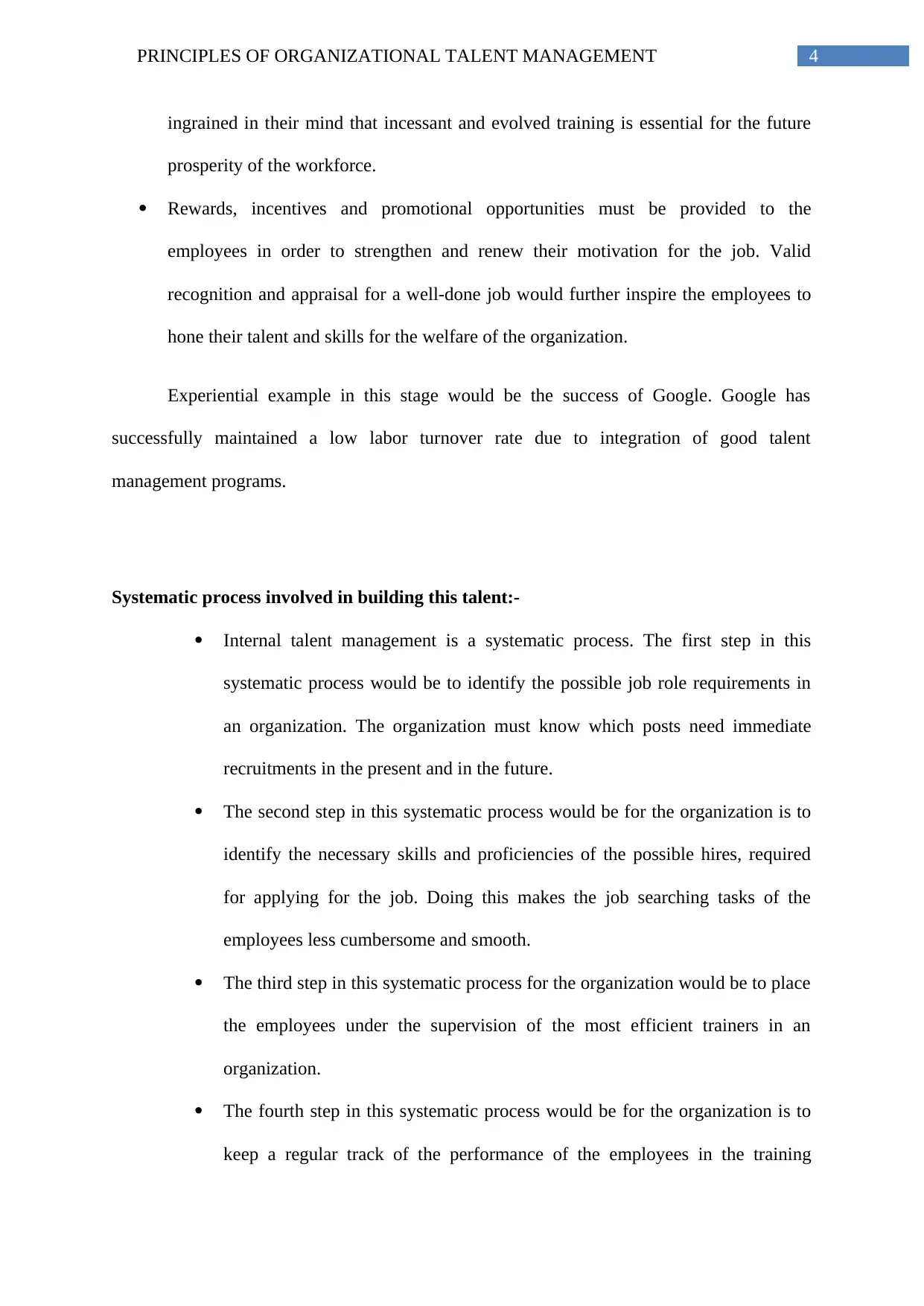
4PRINCIPLES OF ORGANIZATIONAL TALENT MANAGEMENT
ingrained in their mind that incessant and evolved training is essential for the future
prosperity of the workforce.
Rewards, incentives and promotional opportunities must be provided to the
employees in order to strengthen and renew their motivation for the job. Valid
recognition and appraisal for a well-done job would further inspire the employees to
hone their talent and skills for the welfare of the organization.
Experiential example in this stage would be the success of Google. Google has
successfully maintained a low labor turnover rate due to integration of good talent
management programs.
Systematic process involved in building this talent:-
Internal talent management is a systematic process. The first step in this
systematic process would be to identify the possible job role requirements in
an organization. The organization must know which posts need immediate
recruitments in the present and in the future.
The second step in this systematic process would be for the organization is to
identify the necessary skills and proficiencies of the possible hires, required
for applying for the job. Doing this makes the job searching tasks of the
employees less cumbersome and smooth.
The third step in this systematic process for the organization would be to place
the employees under the supervision of the most efficient trainers in an
organization.
The fourth step in this systematic process would be for the organization is to
keep a regular track of the performance of the employees in the training
ingrained in their mind that incessant and evolved training is essential for the future
prosperity of the workforce.
Rewards, incentives and promotional opportunities must be provided to the
employees in order to strengthen and renew their motivation for the job. Valid
recognition and appraisal for a well-done job would further inspire the employees to
hone their talent and skills for the welfare of the organization.
Experiential example in this stage would be the success of Google. Google has
successfully maintained a low labor turnover rate due to integration of good talent
management programs.
Systematic process involved in building this talent:-
Internal talent management is a systematic process. The first step in this
systematic process would be to identify the possible job role requirements in
an organization. The organization must know which posts need immediate
recruitments in the present and in the future.
The second step in this systematic process would be for the organization is to
identify the necessary skills and proficiencies of the possible hires, required
for applying for the job. Doing this makes the job searching tasks of the
employees less cumbersome and smooth.
The third step in this systematic process for the organization would be to place
the employees under the supervision of the most efficient trainers in an
organization.
The fourth step in this systematic process would be for the organization is to
keep a regular track of the performance of the employees in the training
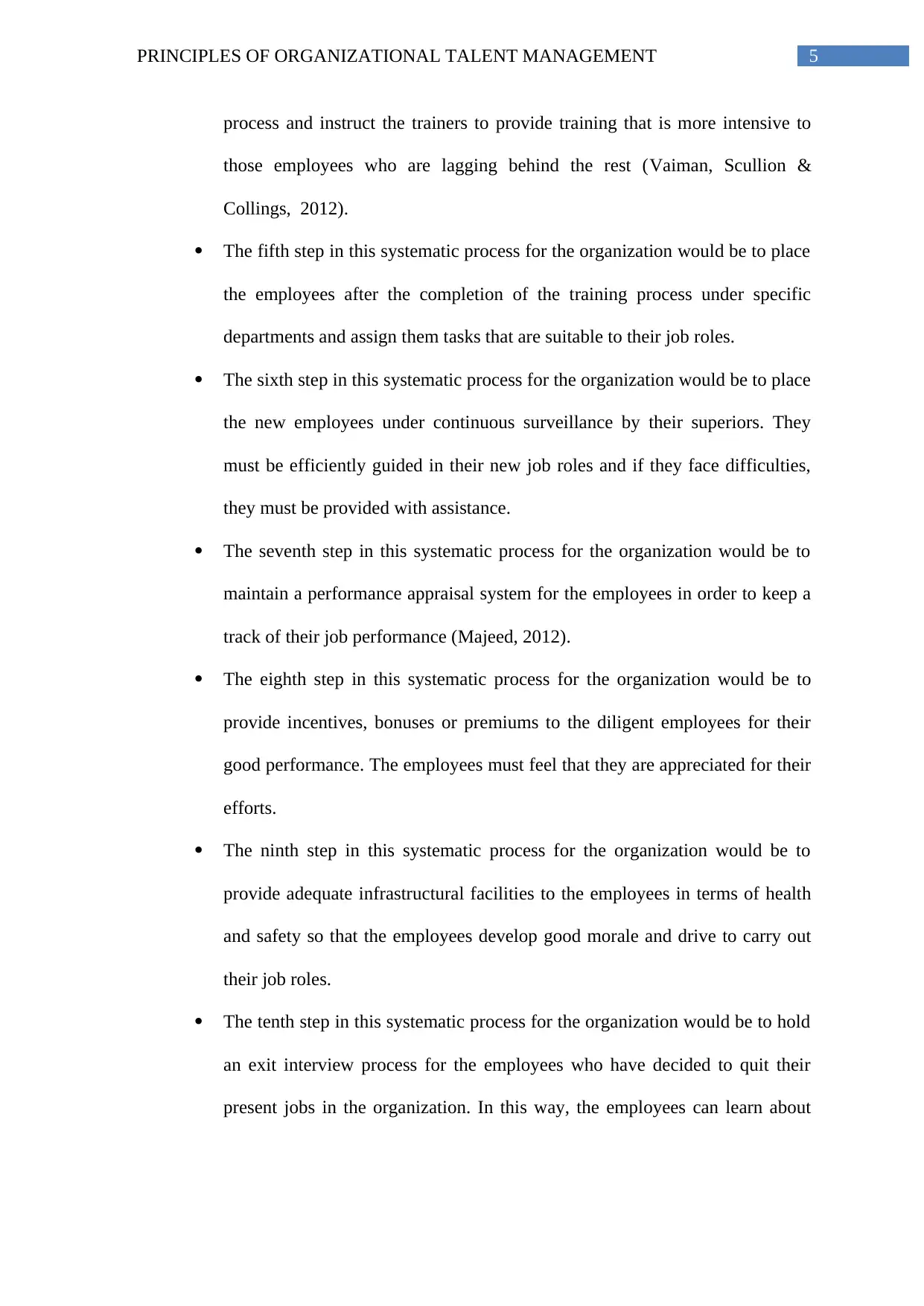
5PRINCIPLES OF ORGANIZATIONAL TALENT MANAGEMENT
process and instruct the trainers to provide training that is more intensive to
those employees who are lagging behind the rest (Vaiman, Scullion &
Collings, 2012).
The fifth step in this systematic process for the organization would be to place
the employees after the completion of the training process under specific
departments and assign them tasks that are suitable to their job roles.
The sixth step in this systematic process for the organization would be to place
the new employees under continuous surveillance by their superiors. They
must be efficiently guided in their new job roles and if they face difficulties,
they must be provided with assistance.
The seventh step in this systematic process for the organization would be to
maintain a performance appraisal system for the employees in order to keep a
track of their job performance (Majeed, 2012).
The eighth step in this systematic process for the organization would be to
provide incentives, bonuses or premiums to the diligent employees for their
good performance. The employees must feel that they are appreciated for their
efforts.
The ninth step in this systematic process for the organization would be to
provide adequate infrastructural facilities to the employees in terms of health
and safety so that the employees develop good morale and drive to carry out
their job roles.
The tenth step in this systematic process for the organization would be to hold
an exit interview process for the employees who have decided to quit their
present jobs in the organization. In this way, the employees can learn about
process and instruct the trainers to provide training that is more intensive to
those employees who are lagging behind the rest (Vaiman, Scullion &
Collings, 2012).
The fifth step in this systematic process for the organization would be to place
the employees after the completion of the training process under specific
departments and assign them tasks that are suitable to their job roles.
The sixth step in this systematic process for the organization would be to place
the new employees under continuous surveillance by their superiors. They
must be efficiently guided in their new job roles and if they face difficulties,
they must be provided with assistance.
The seventh step in this systematic process for the organization would be to
maintain a performance appraisal system for the employees in order to keep a
track of their job performance (Majeed, 2012).
The eighth step in this systematic process for the organization would be to
provide incentives, bonuses or premiums to the diligent employees for their
good performance. The employees must feel that they are appreciated for their
efforts.
The ninth step in this systematic process for the organization would be to
provide adequate infrastructural facilities to the employees in terms of health
and safety so that the employees develop good morale and drive to carry out
their job roles.
The tenth step in this systematic process for the organization would be to hold
an exit interview process for the employees who have decided to quit their
present jobs in the organization. In this way, the employees can learn about
⊘ This is a preview!⊘
Do you want full access?
Subscribe today to unlock all pages.

Trusted by 1+ million students worldwide
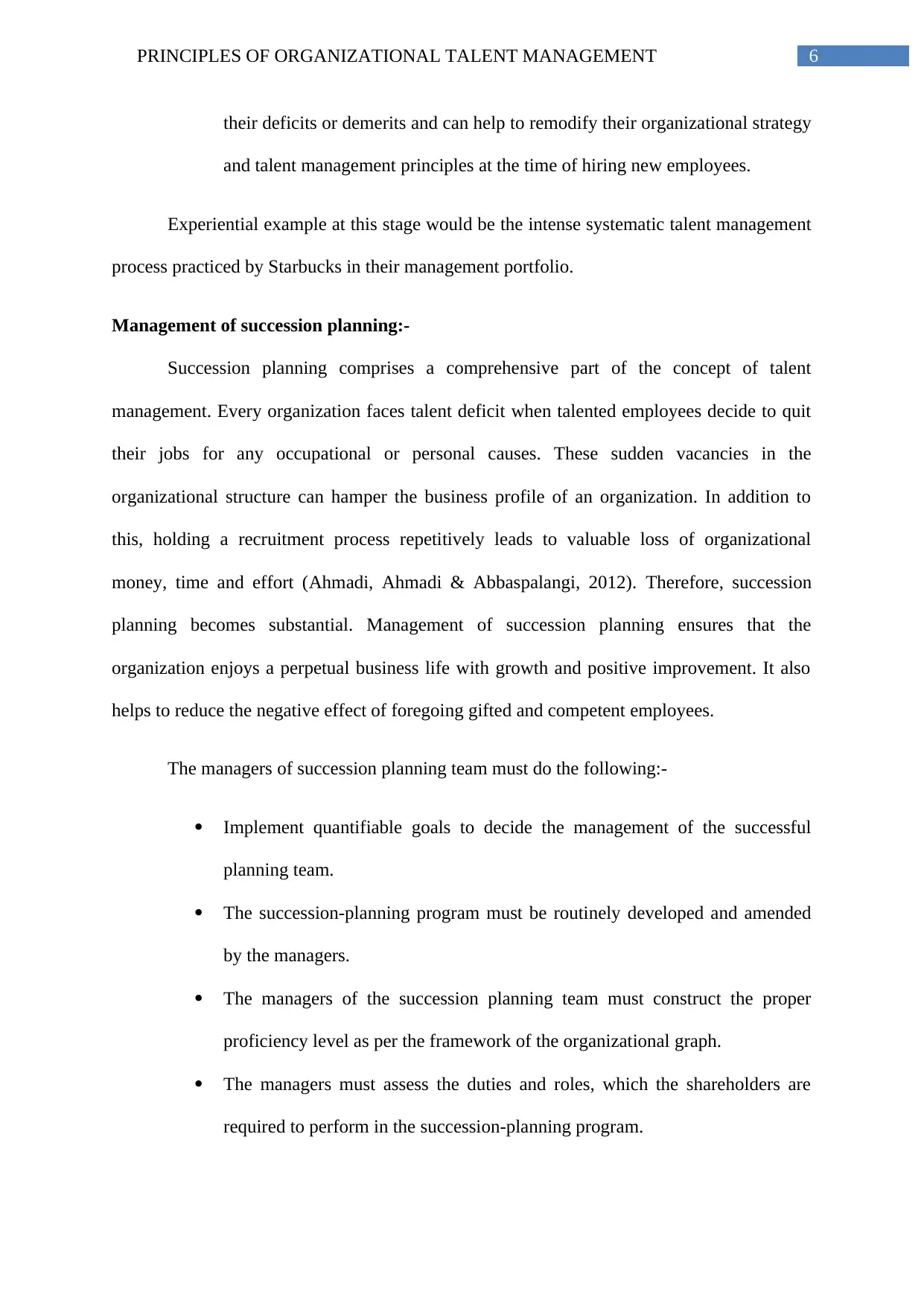
6PRINCIPLES OF ORGANIZATIONAL TALENT MANAGEMENT
their deficits or demerits and can help to remodify their organizational strategy
and talent management principles at the time of hiring new employees.
Experiential example at this stage would be the intense systematic talent management
process practiced by Starbucks in their management portfolio.
Management of succession planning:-
Succession planning comprises a comprehensive part of the concept of talent
management. Every organization faces talent deficit when talented employees decide to quit
their jobs for any occupational or personal causes. These sudden vacancies in the
organizational structure can hamper the business profile of an organization. In addition to
this, holding a recruitment process repetitively leads to valuable loss of organizational
money, time and effort (Ahmadi, Ahmadi & Abbaspalangi, 2012). Therefore, succession
planning becomes substantial. Management of succession planning ensures that the
organization enjoys a perpetual business life with growth and positive improvement. It also
helps to reduce the negative effect of foregoing gifted and competent employees.
The managers of succession planning team must do the following:-
Implement quantifiable goals to decide the management of the successful
planning team.
The succession-planning program must be routinely developed and amended
by the managers.
The managers of the succession planning team must construct the proper
proficiency level as per the framework of the organizational graph.
The managers must assess the duties and roles, which the shareholders are
required to perform in the succession-planning program.
their deficits or demerits and can help to remodify their organizational strategy
and talent management principles at the time of hiring new employees.
Experiential example at this stage would be the intense systematic talent management
process practiced by Starbucks in their management portfolio.
Management of succession planning:-
Succession planning comprises a comprehensive part of the concept of talent
management. Every organization faces talent deficit when talented employees decide to quit
their jobs for any occupational or personal causes. These sudden vacancies in the
organizational structure can hamper the business profile of an organization. In addition to
this, holding a recruitment process repetitively leads to valuable loss of organizational
money, time and effort (Ahmadi, Ahmadi & Abbaspalangi, 2012). Therefore, succession
planning becomes substantial. Management of succession planning ensures that the
organization enjoys a perpetual business life with growth and positive improvement. It also
helps to reduce the negative effect of foregoing gifted and competent employees.
The managers of succession planning team must do the following:-
Implement quantifiable goals to decide the management of the successful
planning team.
The succession-planning program must be routinely developed and amended
by the managers.
The managers of the succession planning team must construct the proper
proficiency level as per the framework of the organizational graph.
The managers must assess the duties and roles, which the shareholders are
required to perform in the succession-planning program.
Paraphrase This Document
Need a fresh take? Get an instant paraphrase of this document with our AI Paraphraser

7PRINCIPLES OF ORGANIZATIONAL TALENT MANAGEMENT
Maintaining a checklist of the talent quotient is another important role to be
performed by the succession planning management team.
Last but not the least, the succession-planning program must be continuously
analyzed and appraised by the managers of the succession-planning team.
Experiential example at this stage would be the case of Citigroup. In the advent of
sudden departure of their previous manager, the implementation of succession planning
programs saved them from grave business loss.
Conclusion
Conclusively, from the above analysis it can be deduced that talent management is
very vital for the organizational health and functionality. Happy and satisfied employees are
the key to success in an organization. Resultantly, they must be nurtured and developed in the
organization with efficient care, responsibility and guidance. Proper designing of the talent
management program both in terms of internal and external perspectives and a successful
planning program are essential for building up organizational credibility and eminence.
Maintaining a checklist of the talent quotient is another important role to be
performed by the succession planning management team.
Last but not the least, the succession-planning program must be continuously
analyzed and appraised by the managers of the succession-planning team.
Experiential example at this stage would be the case of Citigroup. In the advent of
sudden departure of their previous manager, the implementation of succession planning
programs saved them from grave business loss.
Conclusion
Conclusively, from the above analysis it can be deduced that talent management is
very vital for the organizational health and functionality. Happy and satisfied employees are
the key to success in an organization. Resultantly, they must be nurtured and developed in the
organization with efficient care, responsibility and guidance. Proper designing of the talent
management program both in terms of internal and external perspectives and a successful
planning program are essential for building up organizational credibility and eminence.
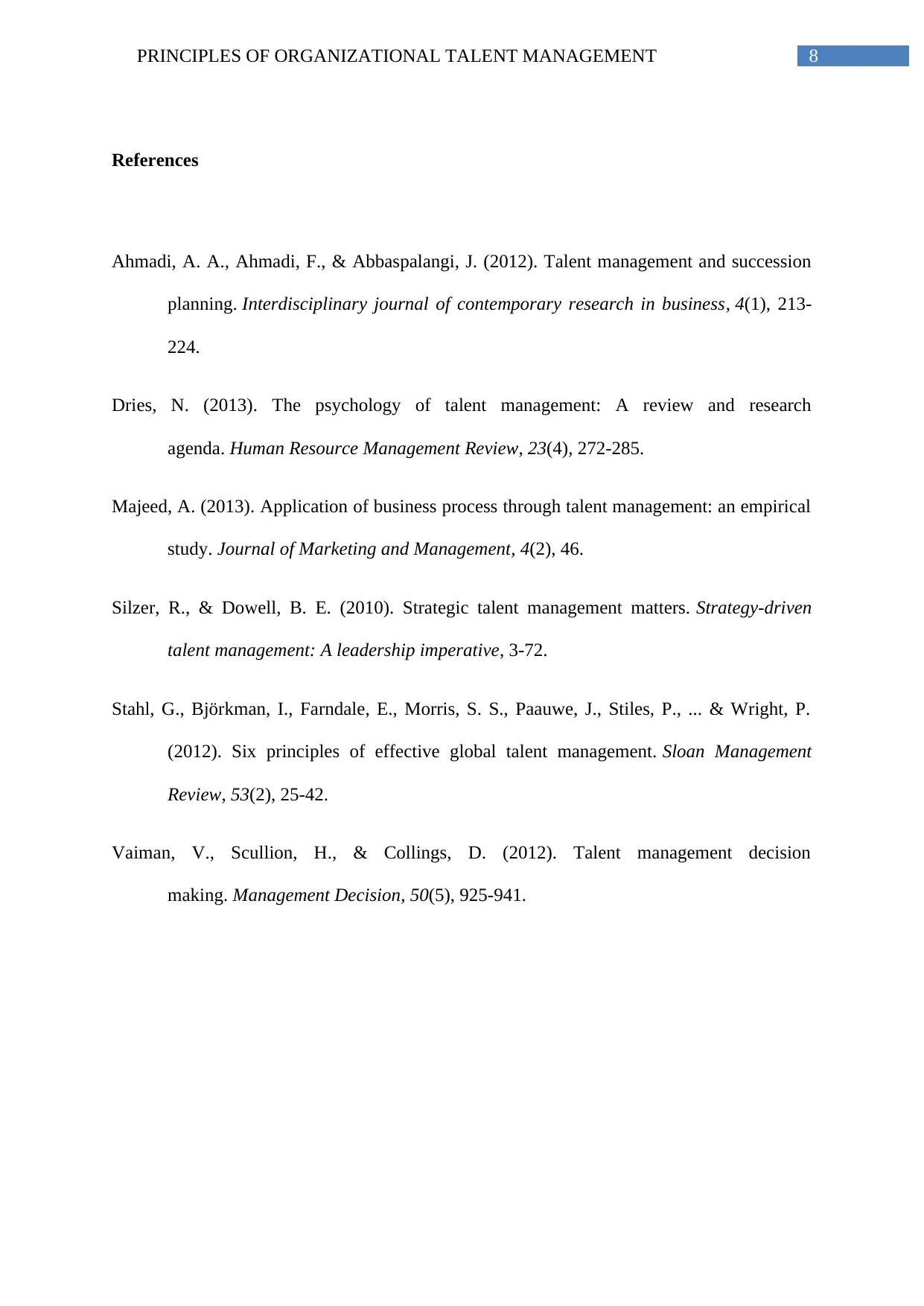
8PRINCIPLES OF ORGANIZATIONAL TALENT MANAGEMENT
References
Ahmadi, A. A., Ahmadi, F., & Abbaspalangi, J. (2012). Talent management and succession
planning. Interdisciplinary journal of contemporary research in business, 4(1), 213-
224.
Dries, N. (2013). The psychology of talent management: A review and research
agenda. Human Resource Management Review, 23(4), 272-285.
Majeed, A. (2013). Application of business process through talent management: an empirical
study. Journal of Marketing and Management, 4(2), 46.
Silzer, R., & Dowell, B. E. (2010). Strategic talent management matters. Strategy-driven
talent management: A leadership imperative, 3-72.
Stahl, G., Björkman, I., Farndale, E., Morris, S. S., Paauwe, J., Stiles, P., ... & Wright, P.
(2012). Six principles of effective global talent management. Sloan Management
Review, 53(2), 25-42.
Vaiman, V., Scullion, H., & Collings, D. (2012). Talent management decision
making. Management Decision, 50(5), 925-941.
References
Ahmadi, A. A., Ahmadi, F., & Abbaspalangi, J. (2012). Talent management and succession
planning. Interdisciplinary journal of contemporary research in business, 4(1), 213-
224.
Dries, N. (2013). The psychology of talent management: A review and research
agenda. Human Resource Management Review, 23(4), 272-285.
Majeed, A. (2013). Application of business process through talent management: an empirical
study. Journal of Marketing and Management, 4(2), 46.
Silzer, R., & Dowell, B. E. (2010). Strategic talent management matters. Strategy-driven
talent management: A leadership imperative, 3-72.
Stahl, G., Björkman, I., Farndale, E., Morris, S. S., Paauwe, J., Stiles, P., ... & Wright, P.
(2012). Six principles of effective global talent management. Sloan Management
Review, 53(2), 25-42.
Vaiman, V., Scullion, H., & Collings, D. (2012). Talent management decision
making. Management Decision, 50(5), 925-941.
⊘ This is a preview!⊘
Do you want full access?
Subscribe today to unlock all pages.

Trusted by 1+ million students worldwide
1 out of 9
Related Documents
Your All-in-One AI-Powered Toolkit for Academic Success.
+13062052269
info@desklib.com
Available 24*7 on WhatsApp / Email
![[object Object]](/_next/static/media/star-bottom.7253800d.svg)
Unlock your academic potential
Copyright © 2020–2025 A2Z Services. All Rights Reserved. Developed and managed by ZUCOL.




